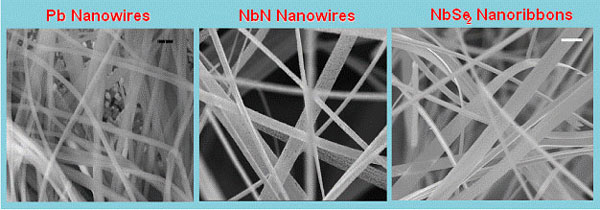- Zhili Xiao, Ph.D.
- Projects
- Nanoribbons
Superconducting Nanowires, Nanostrips, and Nanoribbons
When copper pairs in a superconductor are squeezed into a small volume comparable to the coherence length or penetration depth, their wave functions will be strongly modified. Therefore, mesoscale superconductors are expected to exhibit properties different from bulk materials. For example, new phenomena such as vortex-antivortex pairs and fractional flux quanta have been observed in two-dimensional (2D) superconducting microstructures. A fundamental question is how collective properties of superconductors are affected with further reduction of the dimensionality from 2D to 1D. This issue is also of practical importance in defining the size limit of a superconducting wire with regards to potential applications in electronic circuits.
We have been working on developing novel approaches to synthesizing superconducting nanowires and nanoribbons: we fabricated lead (Pb) nanowires by utilizing nanochannels in porous membranes of anodic aluminum oxide (AAO). We also developed a two-step approach to synthesize superconducting nanowires and nanoribbons by controlled adjustment of the Se composition in NbSe3 nanostructure precursors [Y. S. Hor et al., Nano Letters 5, 397 (2005); Applied Physics Letters 87, 142506 (2005)]. For example, NbN nanowires and nanoribbons with superconducting critical temperature up to 12 Kelvin were obtained by annealing NbSe3 precursors in ammonia gas [U. Patel et al., Applied Physics Letters 91,162508 (2007); Physical Review B 80, 147003 (2009)]. We are also working on synthesis of NbSe2 and MgB2 nanowires with solution based approaches.
We have also studied 1D Nb strips with and without chain of naoscale holes [J. Hua et al., Physical Review Letters 101, article# 077003 (2008) and G. R. Berdiyorov et al., Physical Review Letters 109, 057004 (2012)].
We have been pursuing confinement-induced anisotropy change, phase slips and vortex physics in superconducting nanowires, nanostrips, and nanoribbons.
